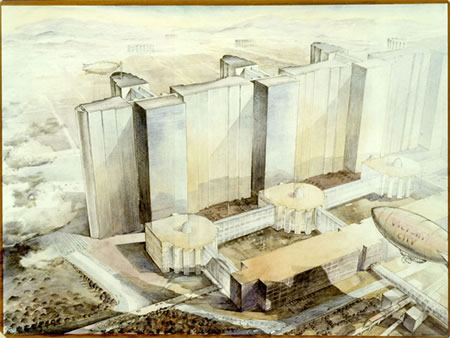
"Investors wanted", reads the link on the website for Victory City.
For over 70 years, the brilliantly named Orville Simpson II has been dreaming of the utopian community of Victory City. Starting with a childhood vision in 1936, and with no formal architectural or town planning training, Orville has been creating blueprints, drawings and residents manuals for his revolutionary, prototype community since 1960, He plans to build the first one just outside Dayton, Ohio, but is having problems finding the $100 million of private investment he feels he needs to create a development corporation.
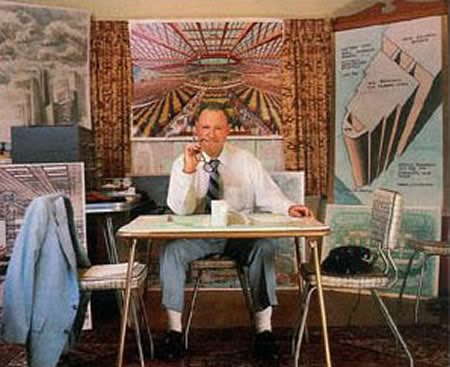
Each Victory City is a megastructure, up to 102 storeys high, housing up to 332,000 residents in 7 conjoined modules, each holding 47,500, with associated living quarters, workplaces, recreation facilities, and transportation. Outlying farms supply food to support the city. The central concept of Victory City is that by keeping all of these functions in a unified structure, and with radical changes in living patterns that VC dictates, great efficiencies can be made in transportation, energy and waste. Over 30 years of drawing, done on the card table office desk, Orville ("the name means golden city", he declares) has planned, drafted and described in great detail exactly how Victory City will look, and work, should he find the millions of dollars required to build it, and enough people to fill it. As other pioneering urbanists such as Paolo Soleri has discovered at Arcosanti, the road to radical urbanism is a long and fraught one.
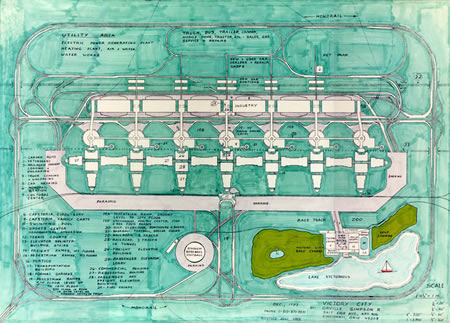
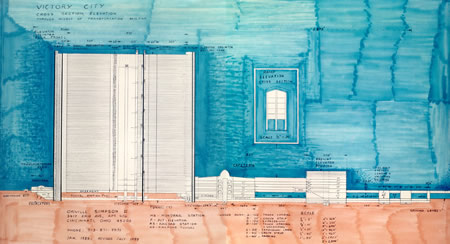
In order to facilitate such a huge megastructure, Simpson has also envisaged a number of novel technical solutions, such as the Circl-Serv cafeteria system that promises to "feed 16,333 people in only 3½ hours." Rather than buy and prepare their own food, Simpson has decreed that all VC citizens will eat in giant skylit cafeterias. Scaling this up to feed 300,000 people results in a series of 9-storey mega food courts with a crazed series of Ferris wheel and Circl-Serv delivery system.
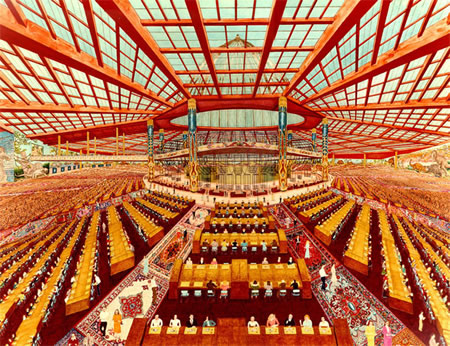
Likewise, he goes into great depths determining how the lift systems will work, with a series of Extra-Large Elevators designed to carry 50 people at a time. Still, one can't help but think that a VC resident will spend a lot of time waiting for lifts or standing in them.
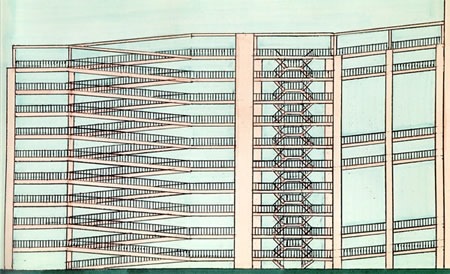
While Simpson II has thought in minute detail about the intricacies of mass catering and vertical transportation, he is less clear about the bigger picture, How will Victory Cities, with their radical social model, and built form, deal with the rest of the world. Would outsiders be allowed in, and would VC citizens be allowed out? In keeping everything together in a city-state mega-block, citizens' relationship with the outside world is fractured, except for the sanitised exterior landscape - a hexagonal arrangement of lakes, forests, farms, hills, mines and oil wells around a Separate Facilities mega-plex holding an eclectic mix of functions including an airport, a race track, car dealerships and chicken farms.
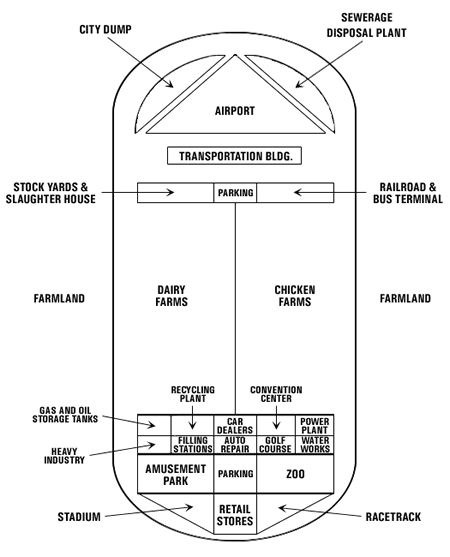
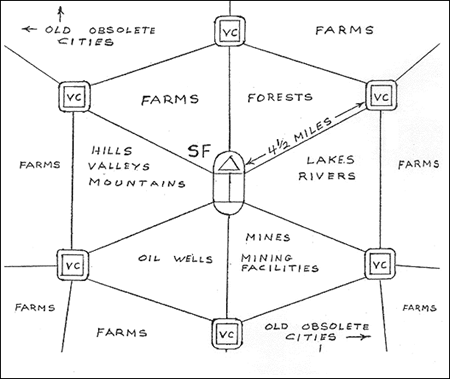
Simpson has effectively designed a landlocked prison ship as a pioneering urban community.
The first thing that betrays Simpson's ideas are the crudeness of his drawings, The insane felt-tip colouring-in and wobbly lettering leaves you in no doubt that these are child-like drawings of someone with a child-like simplistic view of society. A millionaire, and he can't afford a stencil and some Letratone? Intense sectional drawings of immense fire-escape structures show the obsession with circulation and procession.
By contrast, the apartments are generally small and pokey - none seem to have windows. On occasions, he has recruited architectural students and artists to create more polished or atmospheric renderings. Inevitably for such a long undertaking, progress on Victory City seems to have had periods of intense activity followed by long fallow periods.
As with most utopian socialists, new building forms are intended to bring new societies, and fix perceived problems with existing society. At Victory City, these manifest themselves in a number of extreme social control measures. Thus in Victory City residents will carry no money. Apartments will be ready furnished. While caged birds and goldfish are allowed, cats and dogs are not - instead larger animals must be kept in a Pet Park.
Simpson's Orwellian vision continues with more residential guidelines:
"Another possibility will be to install a Muzak-type system in each apartment so residents could listen to a central source of music, news and other programs whenever they wanted. All of these programs could be turned off by Victory City between 10-11 PM, and the volume turned down between 9-10 PM in order to enable people to sleep better at night. Separate loudspeakers could be used for emergency announcements, which should be regulated by Victory City, independent of the tenants' control."
It's not hard to see flaws in Simpsons utopian vision. He sees no apparent conflict between the draconian social control he covets, its all-powerful state apparatus, and a market economy. There is almost no space given over to commercial usage - retail or business. The city-state holds a monopoly on everything from catering, home furnishings and postal. There will be no taxes, apparently. Crime and social disorder have not been considered, other than a vague panopticon surveillance.
It's easy to dismiss Simpson as a nutjob in a polyester suit with a nose like WC Fields, but is there really any difference between Victory City and say Broadacre City, other than that they are much better drawn, the social engineering not so boldly stated? While Simpson might be more forceful in his desire to model the citizens of Victory City to his values, all utopian socialists inevitably wish to builld society in their own image. And you have to admire the dedication and hubris of a man who has spent over 50 years dreaming and designing his own personal utopia.
Perhaps Victory City has more in common with Gilles Trehain's Urville than La Ville Radieuse.
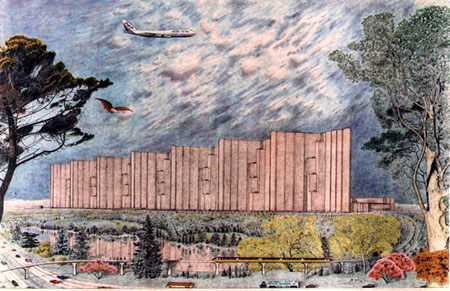
There is so much great stuff to discover about Victory City, that I can only urge you to visit the website and explore for yourself. As the man says himself: "Victory City is riddled with logic — riddled and impregnated with it. Total logic."
Previously:
